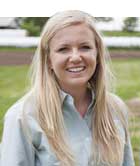Breeding for hill-climbing cattle |
| By Sydney Sleep |
|
|
|
Most cattle tend to graze in valleys and congregate by creeks, leading to overgrazing in riparian areas and letting quality forage on hillsides go to waste. However, some cattle are different, preferring to climb hills and mountains while grazing along the way. If more cattle grazed hills, rangelands would be more productive and sustainable. A team of researchers, including University of California-Davis animal geneticist Juan Medrano, is working to develop an easy, inexpensive genetic test to help ranchers improve cattle distribution by breeding hill-climbing cows. “DNA technology makes it relatively easy to test and breed for production traits like milk yield and growth rate, but it’s brand new to identify genetic markers linked to animal behavior,” says Medrano in the UC-Davis Food and Agriculture news. “This could have a huge impact on food security and rangeland management.” Grazing on rangeland provides feed for livestock and offers many environmental benefits. However, problems arise when rangeland is overgrazed and cattle spend too much time near running water, where manure can create water-quality risks for people downstream. In California this is especially true, where about 80 percent of drinking and irrigation water is stored on or passes through rangeland. For decades, researchers have been working with ranchers to keep cattle from overgrazing and congregating by creeks. Their strategies have included building strategic fencing and providing water and salt licks on ridge tops away from running water. However, several years ago Derek Bailey, professor of range science at New Mexico State University, had a thought: What if we combine nature and nurture? If cattle can be bred for other traits, why can’t we select for hill climbing? Bailey joined Medrano and a team of researchers, and they are close to developing a genetic test for whether a bull is likely to sire daughters who like to climb hills. To identify hill-climbing cattle, the researchers put GPS collars on 180 cows on seven ranches in three Western states. They took measurements every 10 minutes for several months at a time. The team tracked the cattle’s slope use, elevation gain, and distance traveled from water. They also took blood samples and analyzed them for chromosomal commonalities. Overlap in genes linked to locomotion, motivation, and spatial learning were found. “Results so far are very encouraging,” says Medrano. “Soon we will be able to test and breed for hill-climbing behavior.” Since breeding for a specific trait can sometimes produce unintended consequences like predisposition to disease or low calf weight, the researchers are closely looking into that possibility. So far no correlation between hill-climbing behavior and undesired traits has been found. The team has studied calf-weaning weights, pregnancy rates, blood pressure, and disposition to see if certain traits cause hill-climbers. However, they have concluded that some cattle just prefer to climb more than others.  Sydney Sleep Sydney Sleep was the 2016 Hay & Forage Grower summer editorial intern and is a junior at South Dakota University. |

